![[Metroactive Features]](/features/gifs/feat468.gif)
[ Features Index | San Jose | Metroactive Central | Archives ]
Pet Project: The Brite Lite Neon Sign Co. built the Andy's Pet Shop sign in 1950, where it has hung over the sidewalk along The Alameda almost undisturbed ever since. At one point, a big rig making a tight turn smashed into it, requiring repairs.
Telltale Signs
One reporter goes fishing for the Valley's sign delights, from the blasphemous to the ridiculous
By Genevieve Roja
YEARS AFTER THE FACT, the Saturday ritual of my childhood remains crisp in my mind. My brother, father and I would ride bikes from a park called Blackie's Pasture in my Northern California hometown and head for Paradise Burgers. I always knew we were close when I spotted the sign in the distance, an oval-shaped, hand-painted sign with block lettering in a semicircle around a palm tree. Red-faced and sweaty, I ordered my favorite, a double scoop of chocolate chip and rocky road, two ice cream flavors partially responsible for my 9-year-old gut and my insatiable adult appetite for sweets. Clutching our ice cream in our fists, we'd head down the street and around the corner, on Main Street, passing more places with hand-painted and neon signs: Sam's Cafe, Swedish House Bakery.
Even after I moved away, on visits I've noted that some signs have remained. I'm not certain if Paradise is still there, but I hear Swedish House is in operation and know Sam's is doing good business, thanks to the influx of yuppie San Francisco transplants that brunch on Bloody Marys and Mimosas, seaside. Despite the presence of impostors, I am comforted each time I visit by the way things have managed to stay the same, in a slow-growth kind of way. And the signs lend a homey quality to my visits, reassuring passersby with a "We're still here and we're not going anywhere" attitude. These signs root me in the past, chronicle an era, capture an ice cream moment in time.
In San Jose, the signs seem to evoke similar feelings. I sometimes catch myself looking in the rearview mirror or craning my head at a red light to see, one more time, the Orchard Supply Hardware neon sign on San Carlos or the dancing neon pig at Stephen's Pork Products on Montgomery Street. I can't help but wonder what San Jose was like, who its people were and how they lived back when those signs were first constructed.
There is not one person I interviewed about signs who didn't say, at least once, "I remember when ..." There's always something to remember when it comes to the valley's signs, and signs in general, because they give us a sense of home, comfort, belonging. Signs allow us to brand communities as our own.
A handful of sign preservationists in cities such as San Francisco, Los Angeles and Vancouver, British Columbia, recognize this. They argue at town councils, governing boards and politicians. They have websites, create T-shirts to rally support for a decrepit sign. They do their job, in part, because they know once a piece of history is gone, it's gone forever.
In Vancouver, preservationists have scrambled to preserve remnants of their city's neon illuminated past. After World War II, Vancouver's streets buzzed with neon, including Granville Street, which some compared to New York's Broadway glitter gulch. At its peak, more than 18,000 neon signs glowed in Vancouver.
Two years ago, the Vancouver Museum hosted a yearlong exhibition called "City Lights: Neon in Vancouver." Because of the enthusiasm it generated, the museum will remount the show later this year. The museum, in conjunction with Heritage Vancouver, also conducts four-hour bus tours of the city's neon highlights. Visitors are driven to several spots by vintage bus--either a 1947 or 1957 Coach, or a 1962 General Motors diesel--to "put people in the mood," Atkin says. Seattle is following suit.
Los Angeles saw the light as well and took steps to claim its gas and glass heritage as a municipal treasure. Under the direction of Cultural Affairs Department veteran Adolfo "Al" Nodal, rooftop neon signs--like those that grace our own Hotel De Anza and Hyatt Sainte Claire--have been preserved. Along Wilshire Boulevard, the oversized signs glow atop deco-era apartments constructed in the 1920s and early 1930s that were once inhabited by stars of Hollywood's Golden Age. Today, pedestrians and motorists on Wilshire can catch a glimpse of what Marion Davies, lover of William Randolph Hearst, experienced during her rides down the boulevard.
"Many of them were the grand apartment complexes of Los Angeles that were built in its period of explosive growth," says Brentstein, whose agency gave Nodal's Wilshire restoration project a preservation award in 1999.
Although Brentstein said he wasn't sure about the exact amount spent on the entire project, much of the funding came from the city's Redevelopment Agency and General Fund. He also knows that the building owners were not charged for the rehabilitation and maintenance that went into preserving the neon signs. Owners were suspicious at the free handout; one of them, who owned the former Broadway Hollywood building, didn't bite at all. It is the same sign in the episode where Lucy, in I Love Lucy, looks out and sees the Broadway, once known as a department store.
"The signs provide a visually compelling reminder of Los Angeles' history and provide a true visual marker around the city in the nighttime sky," Brentstein says.
But the sign preservation doesn't stop there. The restoration project shifts to downtown Los Angeles, where the signs on two old buildings, Rossyln Hotel and the historic movie palace Orpheum Theatre, will be relit.
Signs of the Times: The great disappearing signs have captured preservationists' attention
Preserving signs is seldom at the top of the list for out-of-town corporations that swoop into the South Bay. They have no memories of what used to be a local hangout, a children's shoe store, a barbershop, a robust coffee shop, a thriving cinema. The innumerable real estate companies and property managers I interviewed were hazy on the details of their shopping centers and stores. Some mixed up dates, offered approximations or referred me to corporate offices that, in turn, knew less than the first party. Even property management companies that had bought the mostly family-owned properties were befuddled when asked specific questions, and confessed they had to "do some more digging." Ownership had changed so many times that the current owners were often unfamiliar with the property they had just acquired.
As fast as San Jose and its surrounding areas are growing, there is little time to reflect on what used to be here.
There is also very little solace in the fact that much of the preservation has come from private sources: individuals who acquire old signs for their personal collections, or developers who propose to "move" the sign to a more suitable, out-of-the-way location. Zippy cartoonist Bill Griffith (see related story) brings up that point when he talks about Doggie Diner heads under private ownership. Some doggie owners send him pictures of doggies in the middle of a walnut orchard and another in Santa Barbara overlooking the ocean. The photos are all reassuring, but they lack a frame of reference and lose their context.
"There's something not quite authentic about it," says Griffith about seeing the pictures of discombobulated doggies. "It's much more authentic to see where it had originally been, where it's accessible to everyone, where everyone can see its magnificence."
Judging from my own research, South Bay natives are a little slow on the sign preservation front. I found a few kindred buffs, like Clyde Arbuckle's son Jim, and Metro's own Underbelly columnist, Eric Carlson, but there were few authoritative, expert sources on San Jose's historic or nonhistoric signs. The San Jose Historical Museum professed that they didn't maintain a sign inventory. The San Jose Main Library's most hopeful resource, the California Room, did not catalog signs, although it contains newspaper clippings and occasional original photographs of historic signs and buildings in San Jose. People at the Preservation Action Council of San Jose attempted to route me to a sign buff, apologizing for not being more useful and confessing that preserving Victorians and Queen Anne's were more their forte. San Jose Planning's Historical Landmark Division didn't provide any other information, but could confirm that, yes, Babe's & Lightning Muffler Service was a historic local landmark and that city planning didn't think too highly of its presence on The Alameda.
Because of a still substantial sign inventory here, there's an overwhelming capacity for San Jose to take a leading role in Bay Area sign preservation efforts. Perhaps someone will emerge from the masses impassioned, brawny and willing to start a movement, setting an example for others. But most of all, the great hope is that rallying around sign preservation can become San Jose's signature--if there are still people in the South Bay that care enough to make it so.
Neon Phenom
Neon dominates the streets of San Jose, lighting it up the way Main Street illuminates Disneyland. Helping to produce the valley's neon glare are two rare gases, neon and argon. Neon casts a red glow and is a predominant color in signs; argon, a weaker gas because of its low resistance, boasts less-vibrant shades of yellow, blue, green and white. A neon sign is made with a vacuum-tight, often bent glass tube fitted on both ends with an electrode, which, when connected with a high voltage of electrical power, produces a bright light. The effect is dazzling, making neon an obvious choice for signage.
Falafel Drive-In
Ever since the Nijmeh family purchased the former Snow White Drive-In site in 1966, Falafel Drive-In on West San Carlos has flourished as the one-stop destination for fine Middle Eastern food, helped in no small part by the ubiquitous sign. Only a few months ago, owner Anton Nijmeh brightened the sign by replacing its yellow neon bulbs with red ones to enhance the jumpy blinking arrow.
"It's beautiful, isn't it?" says Michael Nijmeh, one of Anton's sons, who is also a co-manager. "It looks even better lit up at night."
Photograph by George Sakkestad
Western Appliance TV & Stereo
What would the western end of San Carlos be without the gargantuan Western Appliance sign? In the same vein, how would we find our way to San Jose had it not been for the famous jingle, "Western Appliance ... making life much easier for you ..." And what's up with the triple-headed tower? Turns out the three rods sticking out of the sign had balls of neon light blinking like blips on a radar screen. According to store manager Mike Alias, the city of San Jose forced the store to lose the balls, which they claimed averted incoming planes from their real destination, the San Jose Airport. When the store underwent a major renovation a few years ago, owner David Niederauer was faced with a dilemma. The store needed a massive facelift--one that would have required the demolition of the sign, since the tower's "legs" were deeply rooted inside the store. Relocating the sign meant losing it completely. And so Niederauer decided to renovate around the sign and, alas, the sign stood, for better and for good.
Y Not Adult Bookstore
Down the street from Falafel is the Y Not adult bookstore, a can't-miss destination, with its large "Y" and naughty question mark dangling between the letter's cleavage. Once a neighborhood bar under the same name, Dolores Wise's stepfather bought the bar and opened the adult novelty shop in 1974. Wise, who co-owns the store with her mother and sisters, says that, at first, everyone hesitated joining the family business, which clearly posed a challenge to their Christian beliefs. But the job eventually became easier to swallow, and now Wise hardly flinches when customers plunk down 8-inch dildos and edible panties at the counter. Since the business opened in 1974, the store has undergone a few internal changes, but the truly apropos sign has remained in the cherriest of conditions.
O.C. McDonald Co.
Few cruising down San Carlos can avert their eyes from the intermittent "Oh!" and "See!" that flash in fluorescent green neon. Layered underneath, line by line, are "McDonald," "Plumbing," "Heating" and "Sheet Metal," all respectively lit in pink and green neon. None of the employees could specify the exact year of the signage, nor the exact year the business opened, although each acknowledged it was decades old. Judging from the liberal use of pale green and cornhusk yellow art deco-styled writing, O.C. McDonald looks like the kind of drive-through storefront that Gatsby and Daisy might have stopped at before heading to an air-conditioned San Francisco.
This Little Piggy Stayed Home: Owners Stephen and Grace Pizzo came up with the idea of a dancing pig for their business in the late 1940s. Now, they say, art students like to paint it.
Stephen's Meat Products
Dancing swine headed for the meat grinder never looked as good as the one shaking its tail at Stephen's Pork Products. Stephen Tiesel started the company in 1942, and it's believed the sign was erected around 1949 or 1950. Tony Fernandez, a consultant who has worked at Stephen's since the late '40s, says he has the skinny on the piggy. Tiesel and his wife, Grace Pizzo, came up with the idea of the dancing pig.
A local sign outfit, Zeon, manufactured the sign; another company, Ad Art, installed it; and San Jose-based Brite Lite Neon Sign Co. still maintains it. The sign is a humorous contrast to the business, essentially a factory that processes prime cuts of sausage, bologna, salami, ground beef and hamburger patties for restaurants and hotels. Stephen Morrison, one of several family members who help run the plant, says the sign marketing "pure pork sausage" has inspired more than the passing butcher.
"We get a lot of college students down the street who want to sit there and paint it, weird things like that," Morrison says.
Andy's Pet Shop
Who says piggies have all the fun in San Jose? The sign outside of Andy's shows that squawking parrots and faceless goldfish can tear it up and turn it out just as much as the dancing oinker.
Since Brite Lite built the sign and installed it in 1950, the flashing neon animals have been lighting up The Alameda, narrowly escaping a permanent absence from the colorful hub.
According to owner Linda Gaetke, a big rig turned the shop corner and smashed the entire sign. Similar traffic incidents required more sign repairs, and Gaetke notes that because of one accident, the sign sticks straight out of the building instead of at a 45-degree angle, as it once originally sat.
Western Motel
What a sight it might have been in 1950 to witness a valley mirage--a neon cactus in the middle of nowhere. No horses, no lusty ladies, no saloon--just A.C., a heated pool, TV and vacancy. To complete the motif, the word "Western" is written in cowboy cursive, the better to lure the city folk out to the valley wild. According to current owner Abraham Totah, Western Motel was one of half a dozen motels that existed in Santa Clara when his family acquired it in 1958, charging guests a $6 room rate.
"When we got there, El Camino was two streets, there was dirt, there was a fruit stand across the street--I think Mariani's was there," Totah says.
Totah had originally moved west intent on opening a nightclub in Los Angeles until he stumbled upon Western Motel. His pipe dream happened later, with the opening of The Mecca Lounge on El Camino and Flora Vista in Santa Clara in 1963. During its 11-year run, The Mecca Lounge hosted such acts as Al Jarreau (of Moonlighting theme song fame) and Sly and the Family Stone before lesbian bar Savoy took over the space.
Totah doesn't know who designed the Western Motel sign or who built it, although Brite Lite Neon Co. maintains the sign. The Western Motel, however, does have a checkered past. After the Western Motel's first owners, the Manadellas, sold the motel to a German couple (Totah can't recall the names of the couple), the Western had its own version of High Noon. One night three assailants attempted to rob the motel. While one of the marauders choked the owner, his wife "came out shooting," Totah says, killing one bandit and wounding another. He says the woman was never charged with any crime. Talk about your Wild, Wild West.
Photograph by George Sakkestad
Cardinal Hotel
Being the college town that it is, it's no surprise that much of Palo Alto is plastered in cardinal (not the bird, but the shade of red) and white. There's no exception at the Cardinal Hotel--built in 1924--with its marquee sign featuring ornate white lettering set against a cardinal background. According to Palo Alto's historic preservation specialist, Dennis Bucklund, the sign was unlit until neon lettering was added in the 1940s.
Keystone Coffee (formerly at the 5 Spot Drive-In)
Jonesing caffinators could rarely avoid the South First 5 Spot coffee shop thanks to a steaming neon cup of steaming joe that read, "Oh Boy! Keystone Coffee." The sign no longer hangs on top of the roof, but in Keystone's South San Jose warehouse on Charter Park Drive. San Jose-based Rundle Sign Company built the sign in 1944, using the regional coffee supplier's tag line--"Oh Boy! It's the flavor"--as inspiration. From 1944 to 1950, the cup of coffee remained at the South First location before moving to the rooftop of the 5 Spot restaurant on the corner of Ocean and Water streets in Santa Cruz. It rested there from 1951 to 1956. Tim Wright, present owner of Keystone Coffee, says that the sign was so vibrant that motorists and pedestrians could see the San Jose sign from as far away as the intersection point of Market and First streets. In Santa Cruz, people could see the sign coming down on Santa Cruz highway, a feat achieved by its 10-by-20-foot stature. During that period of time, 5 Spot diners around the South Bay--including Los Gatos and Campbell--sold Keystone Coffee, as did grocery stores, garnering a local following and instant name recognition. The 5 Spot dynasty achieved its own notoriety later, when it became Spives Restaurant--the first of San Jose's chain restaurants.
After 1956, the coffee sign moved to the top of the Keystone flagship on Bassett Street, right underneath the Market Street overpass. Back before Starbucks and Peet's and J&B acquisitions, Keystone in San Jose, Peerless in Oakland and United in San Francisco were the only coffee suppliers to their local communities. Peerless and Keystone are the only ones in business to this day; San Francisco's 125 coffee roasting companies have since closed. Wright claims that Keystone Coffee--originally called Eagle Coffee and Spice--is San Jose's oldest business, open since 1867. Most of their business today is still supplying coffee to local restaurants, including Eulipia and Bella Mia, and other restaurants nationwide.
"We sell through a private label program," Wright says, "[so] if you're not drinking Starbucks or Peet's it's probably ours."
Sadly the business that gave San Jose, well, its big business, is heading south--literally. In a matter of months, Wright says his rent will triple, forcing him to move and find a place to lease. He's even attempted to buy the building since occupying it, but the asking price was so absurd, he resigned himself to scouting possible locations in Monterey, Salinas and Watsonville to stay in the business.
"We're frustrated with the fact that the city's creed is 'Bring all the high-tech in,' and not 'Save the Woolworth's downtown,'" he says. "San Jose has become such a disposable city where they're willing to sacrifice all their history in order to get a high-rise in."
Safeway
Initially, no could verify the exact date and history behind the looming Safeway sign visible from Highway 280. Then John English, a commercial archaeologist and principal of Googie Tours in Los Angeles, came through. The sign features the word "Safeway" in cursive letters--outlined in red neon--whose "S" is connected to one asterisk and whose "Y" is paired with another. English cites the Safeway sign as a classic Googie example, a reference to the architectural style of a '50s coffee shop, Googie's, in Los Angeles. The landmark Googie-style (think Sputnik elements and Jetsonesque architecture) dominated Southern California, leaving traces at Disneyland's Tommorowland and eventually permeating the rest of the country before fading into oblivion in the '70s. Safeway wasn't the only headliner. Sharing space was Futurama Lanes, a popular bowling alley designed by architect Pat DeRosa, whom English claims was the bowling architect back then. Futurama eventually closed down in 1989 or 1990, since the entire shopping center was renovated. Piece by piece, the sign was taken down and refurbished, and gained more widespread recognition with a picture and cultural history in the book Googie: Fifties Coffee Shop Architecture, by Alan Hess.
Old Signs: Silicon Valley's Disappearing Legacy
Sign Language: What historic signs say about our lives, and why action is needed to save the valley's scarce reminders of its commercial past.
Hand-Painted Wonders: Long before graffiti, brick buildings were a palette for sign painters. Today, they are endangered species.
Strokes of Genius: An interview with octogenarian sign-painter Rey Giese.
Telltale Signs: Close-up looks at the Courtesy Chevrolet and Orchard Supply Hardware landmark signs.
Pooch Politics: Famed cartoonist takes doggie-head sign to heart.
Living Large: Giant roadside statues are often 'borrowed.'
Signs From the Underbelly: Columnist Eric Carlson offers a photographic tour of some of the most interesting signs in San Jose.
[ San Jose | Metroactive Central | Archives ]
![]()
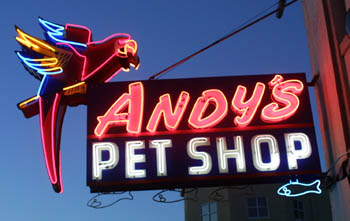
Photograph by George Sakkestad
![[line]](/gifs/line.gif)
![[line]](/gifs/line.gif)
2301 Stevens Creek Blvd., San Jose
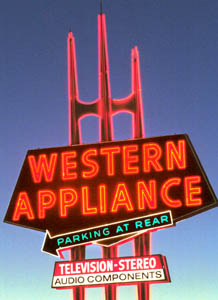 Makin' Life Much Easier for You: But not if you're an airplane. City officials made owners extinguish the three blinking bulbs on this landmark's triple tower to keep from sending the wrong signal to incoming airplanes.The sign's massive 'legs' are located inside the West San Carlos store.
Makin' Life Much Easier for You: But not if you're an airplane. City officials made owners extinguish the three blinking bulbs on this landmark's triple tower to keep from sending the wrong signal to incoming airplanes.The sign's massive 'legs' are located inside the West San Carlos store.
1976 W. San Carlos St., San Jose
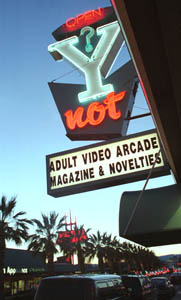
Photograph by George Sakkestad
1933 W. San Carlos St., San Jose
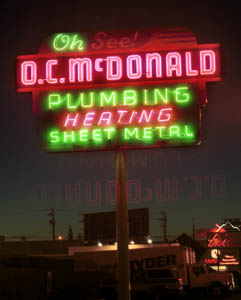
Photograph by George Sakkestad
1150 W. San Carlos St., San Jose
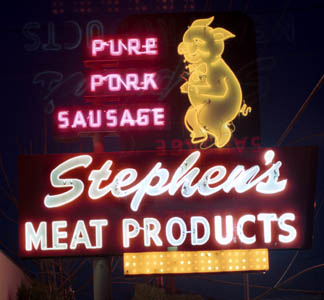
Photograph by George Sakkestad
105. S. Montgomery St., San Jose
1280 The Alameda, San Jose
2250 El Camino Real, Santa Clara
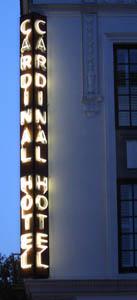 Old Bird: This landmark marquee on Hamilton Avenue in Palo Alto was originally erected in 1924. The high-tech revolution of the 1940s brought its letters to neon life for nighttime viewing.
Old Bird: This landmark marquee on Hamilton Avenue in Palo Alto was originally erected in 1924. The high-tech revolution of the 1940s brought its letters to neon life for nighttime viewing.
235 Hamilton Ave., Palo Alto
869 S. First St., San Jose
5146 Stevens Creek Blvd., San Jose
From the April 26-May 2, 2001 issue of Metro, Silicon Valley's Weekly Newspaper.